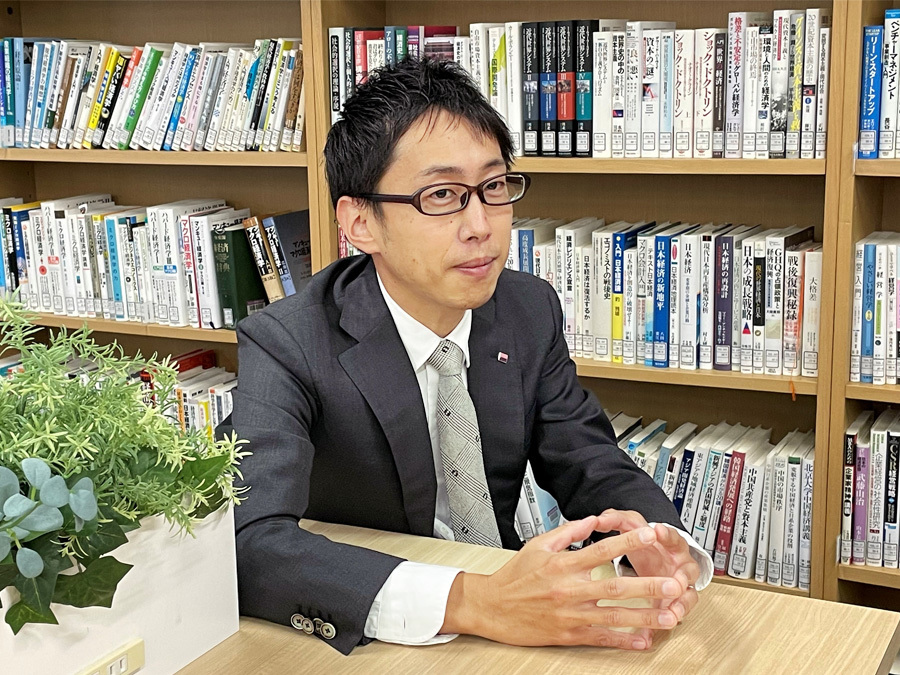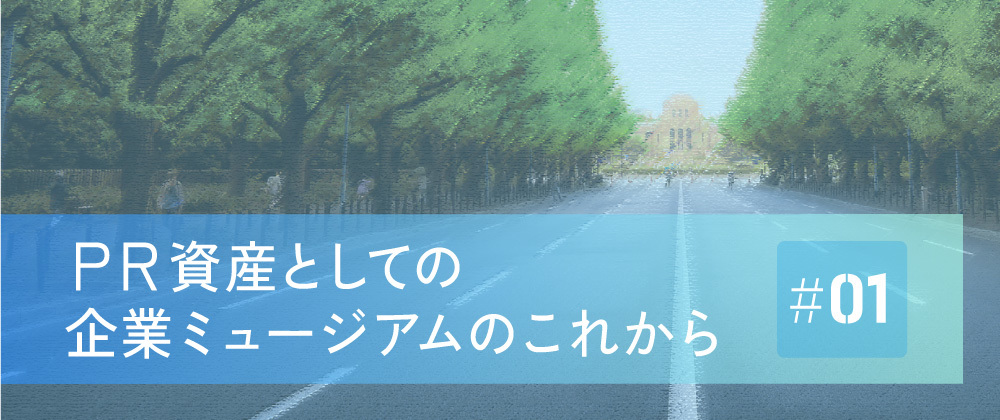Corporate museums occupy a buffer zone spanning both the academic realm of "museums" and the business realm of "corporations." They are organizations that collaborate extensively with corporate departments such as public relations, branding, advertising, and human resources. In this series, PR professionals will introduce various museums operated by corporations, discussing their roles, functions, and potential. In this prologue, #01, Mr. Masahiro Makiguchi, President and CEO of PR Consulting Dentsu Inc., interviews Mr. Naoya Takayanagi of Taisho University.
Corporate museums do not aim for "profitability"
Makiguchi: I find the very subject of your research, corporate museums, extremely unique. Could you first tell us what led you to this field of study?
Takayanagi: It started when I decided to pursue museum curator certification while in university. Back then, it was common knowledge that corporate museums couldn't be profitable on their own. Yet, they held some kind of value that resonated deeply with visitors. Contemporary management theory couldn't explain that. That's precisely why I wanted to research it. Isn't it fascinating to study something no one has yet unraveled?

Naoya Takayanagi: Full-time Lecturer, Faculty of Regional Revitalization, Taisho University
2012: Completed Doctoral Program, Graduate School of Business Administration, Osaka City University; Doctor of Business Administration
Same year: Assistant Professor, College of Culture and Creativity, Shih Chien University (Taiwan)
2015: Specially Appointed Lecturer, Faculty of Commerce, Osaka City University
2016: Full-time Lecturer, Faculty of Business Administration and Graduate School of Management and Information Science, Toyohashi University of Technology
2018: Full-time Lecturer, Faculty of Regional Revitalization, Taisho University (present)
The Importance of "Guides"
Takayanagi: The two major themes of a corporate museum are introducing the company's roots and showcasing the appeal of the industry itself. Well-designed museums simply have no weak points. They cater to all interests, whether for adults or children. The system for guided tours is also impressive.
Makiguchi: Roots, industry, and people, right?
Takayanagi: Corporate museums encapsulate what that company truly values. "Let's make money" and "Let's turn a profit" are certainly important for a company, but take a thermos company, for example. Their passion for "managing heat for the customer" – keeping warm things warm and cold things cold – is immense. Just having the guide who accompanies you explain that passion can really tug at your heartstrings.

Masahiro Makiguchi: President and Representative Director, PR Consulting Dentsu Inc.
After graduating from the University of Tokyo Faculty of Law in 1990, he joined Dentsu Inc. Assigned to the Marketing Bureau, he subsequently served as Director of the IMC Planning Center, Director of the 1CR Planning Bureau, Director of the Corporate Planning Bureau, Director of Corporate Communications, and Director of Public Relations.
In January 2020, he became Managing Executive Officer of PR Consulting Dentsu Inc. In March of the same year, he was appointed President and Representative Director, Executive Officer of PR Consulting Dentsu Inc. In 2021, he was selected as one of the Asia Pacific Innovators 25 by PRovoke Media.
His publications include "Advertising Elementary School: Learn to Communicate Through CM Creation" (Sendenkaigi) and "Why Do You All Start Talking About the Same Things When It Comes to Job Hunting?" (Sendenkaigi). His translations include "Account Planning Changes Advertising" (Diamond Inc.) and "Participatory Ownership Management" (Diamond Inc.).
It's not just about the outside. Communicating internally is also important.
Takayanagi: A museum's value isn't just about showcasing the products a company has created. It's crucial for visitors to truly grasp how society changed when those products entered the world.
This applies not only externally but equally internally. Especially for those in manufacturing, who have few direct opportunities to interact with customers, a corporate museum provides a place for direct engagement with those customers. Naturally, this boosts the morale of the creators. The fact that museums have remained open even during the pandemic is largely due to these reasons. They connect the hearts of management and employees. They connect the hearts of employees themselves. They create interaction with the customers beyond the makers. Corporate museums contribute to this kind of communication, don't they?
Makiguchi: It's important for employees to tangibly experience and share the understanding that their company has been providing products and services to society with such dedication, isn't it?
Takayanagi: Some corporate museums operate at the company's founding location. Even if the headquarters is in Tokyo, I think this reflects a desire to cherish the place where it all began. In municipalities where relatively many young people return after initially moving to Tokyo, there are often companies present. It happens that these young people knew a lot about the company through its museum or similar venues. In that sense too, I believe corporate museums make a contribution.
Museums should actively disclose even their dark history
Takayanagi: I believe every company has some history worth reflecting on, to a greater or lesser extent. Major accidents they caused, or foreign objects they accidentally mixed in. I think one of the attractions of corporate museums is that they openly and honestly display these so-called "dark histories."
For example, few companies deliberately showcase their dark history in advertisements. Yet, I believe the thoughts of "What if we had done this back then?" or "Why couldn't we have done that?" also flow deeply within a company's philosophy and activities. If advertising is about "broad and shallow," then PR represented by corporate museums is about "narrow and deep." Ah, when you truly grasp that even a single screw or a single cup was imbued with such profound thought, that's when true fans are born.

Photo courtesy: Toyota Commemorative Museum of Industry and Technology (left) Shiseido Corporate Archives (right)
What exactly is "entertainment"?
Makiguchi: Places like the movie village in Uzumasa, Kyoto, are a kind of museum, right?
Takayanagi: I think you're absolutely right. The definition of a corporate museum is vague, and the number varies depending on how people count them. But the core of a museum, I believe, is how much it can transform learning about a company or an entire industry into something enjoyable, something you can learn while having fun—something that becomes entertainment. Such efforts eventually become part of the culture.
Makiguchi: Do you have any aspirations for the kind of corporate museum you'd like to encounter in the future? Or perhaps ideas for the kind of museum you'd like to create?
Takayanagi: I think it would be wonderful to have a museum where memories of companies and their products from one's own life are recorded. Imagine visiting such a museum decades later and finding clear traces of how you used that company's products back then, or evidence of your visit to their museum.

Photo courtesy: Nippon Yusen Historical Museum (left) (Closed for renovation from April 1, 2023, to October 2026) / Ad Museum Tokyo (right)
[Editor's Note]
At the end of the interview, the editorial team was given time to ask Mr. Takayanagi a question. I hesitated, wondering what to ask, but finally posed this: "We advertising agency people compete in environments where, for TV commercials, it's a 15-second or 30-second world, and for newspaper or magazine ads, they're flipped past in an instant. In that sense, I think the corporate museum as a medium is a 'place without time constraints.' If it's a place you like, you can enjoy it all day long, from morning until evening. Could we hear your thoughts from that perspective?"
After a brief pause, Mr. Takayanagi responded: "While the time factor is relevant, I believe the real appeal of corporate museums lies in being a tangible 'space'. This connects to the question of 'Who do you go with?' – your partner, friends, or family. If you're having a great time there, you can easily spend hours. For that to happen, I think it's crucial to have not just the physical space and level of completion, but also the 'soft' aspects – like the attentiveness and flexibility of the staff who guide you through the facility."
Mr. Takayanagi's point touches on the very essence of service industries, from famous theme parks and luxury hotels to local pubs. It's not simply about building stylish facilities and arranging items in pretty display cases. This conversation was a real eye-opener, revealing the profound depth and potential of the museum medium itself.











